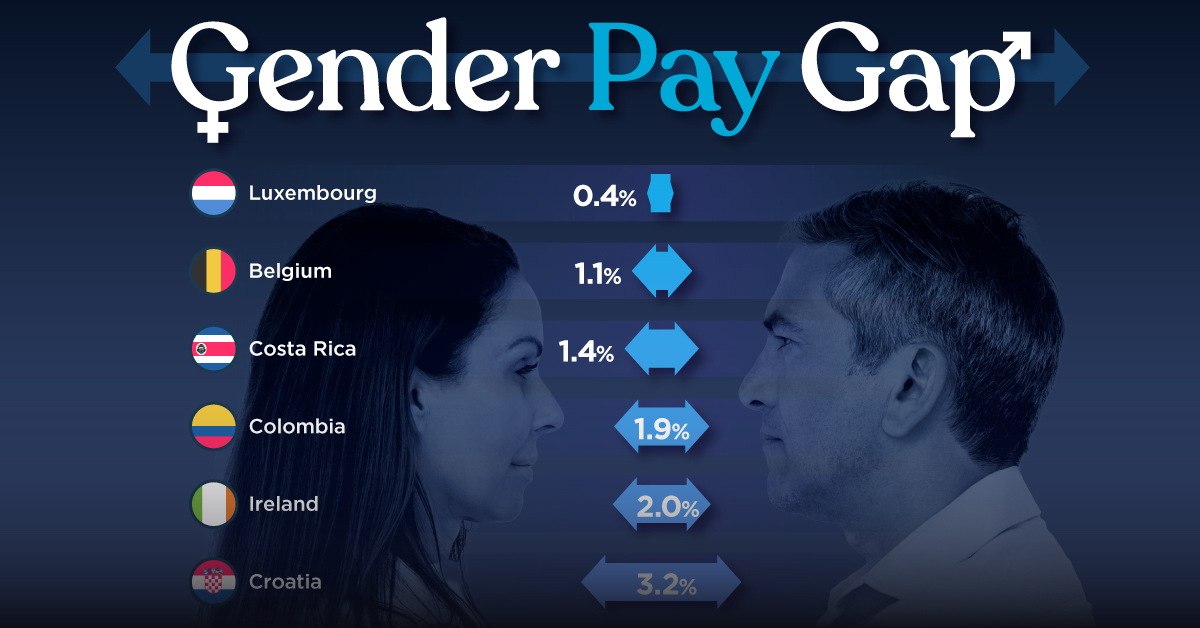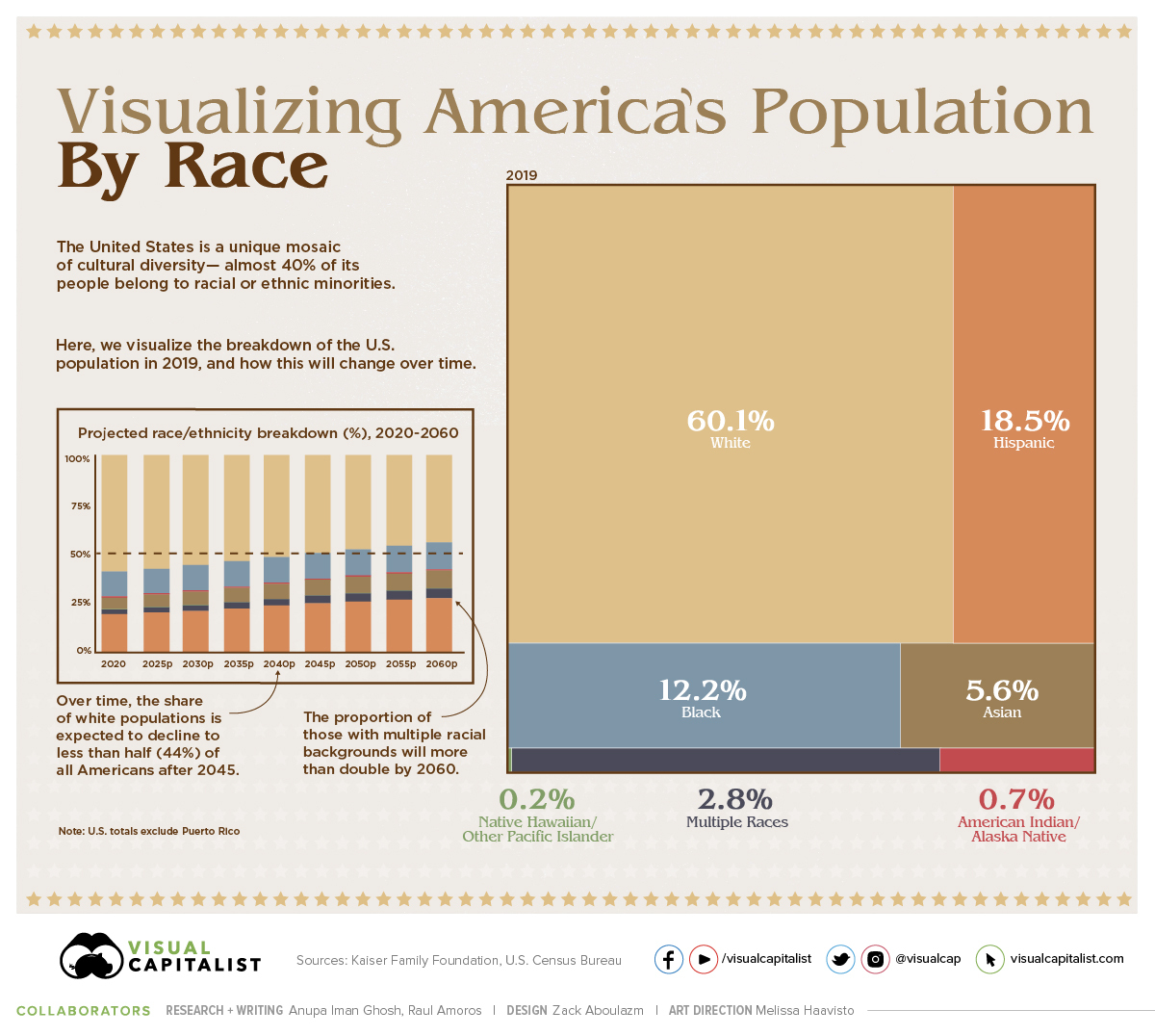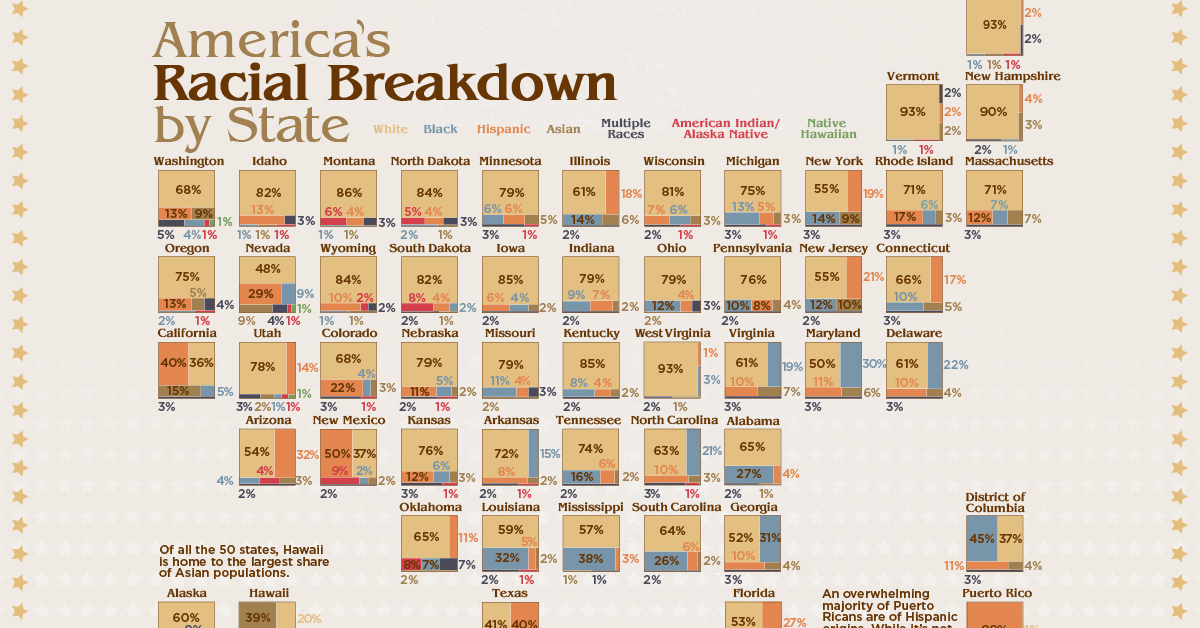Demographics
Visualizing the U.S. Population by Race
How to Use: The below maps will animate automatically. To pause, move your cursor on the image. Arrows on left/right navigate.
Visualizing the U.S. Population by Race
The American population is a unique mosaic of cultures—and almost 40% of people identify as racial or ethnic minorities today.
In this treemap, we use data for 2019 from the Kaiser Family Foundation, which bases its analysis on the latest American Community Survey (ACS) data from the U.S. Census Bureau. Then we break down the same data on a state-by-state basis.
Growing Diversity in America
As of 2019, here is the current distribution of the U.S. population by race and ethnicity:
- White: 60.1% (Non-Hispanic)
- Hispanic: 18.5%
- Black: 12.2%
- Asian: 5.6%
- Multiple Races: 2.8%
- American Indian/Alaska Native: 0.7%
- Native Hawaiian/Other Pacific Islander: 0.2%
Note that the U.S. totals do not include Puerto Rico.
However, these race and ethnicity projections are expected to change over the coming years. By the year 2060, it’s expected that the distribution of Non-Hispanic Whites as a percentage of total population will fall from 60.1% to 44.3% of Americans.
| Year | White* | Black | Hispanic | Asian | Multiple Races | Other** |
|---|---|---|---|---|---|---|
| 2020 | 59.7% | 12.5% | 18.7% | 5.8% | 2.3% | 0.9% |
| 2025 | 57.7% | 12.7% | 19.9% | 6.3% | 2.6% | 0.9% |
| 2030 | 55.8% | 12.8% | 21.1% | 6.7% | 2.8% | 0.9% |
| 2035 | 53.8% | 12.9% | 22.3% | 7.1% | 3.1% | 0.9% |
| 2040 | 51.7% | 13.0% | 23.5% | 7.5% | 3.4% | 0.9% |
| 2045 | 49.7% | 13.1% | 24.6% | 7.9% | 3.8% | 0.9% |
| 2050 | 47.8% | 13.3% | 25.7% | 8.2% | 4.1% | 0.9% |
| 2055 | 46.0% | 13.4% | 26.6% | 8.5% | 4.5% | 0.9% |
| 2060 | 44.3% | 13.6% | 27.5% | 8.9% | 4.9% | 0.9% |
Source: U.S. Census Bureau. *Excludes Hispanics **Other includes American Indian/Alaska Native (0.7%) and Native Hawaiian/Pacific Islander (0.2%). Both proportions remain unchanged in these projections.
Interestingly, the proportion of those from multiple racial and ethnic backgrounds will more than double, from 2.3% to 4.9% alongside rising patterns of interracial marriage.
Over time, the U.S. Census has been vastly expanded to reflect the true diversity that the country holds. In fact, it was only from 1960 onwards that people could select their own race—and only from 2020 can those who chose White or Black provide further information on their roots.
A State-by-State Breakdown
Of course, racial diversity in the United States differs widely from region to region.
In the Northeast—particularly the states Maine, Vermont, and New Hampshire—the Non-Hispanic White population accounts for 90% or more of the total. In contrast, Black populations are highest in the District of Columbia (45%) and several Southern states.
| Location | White | Black | Hispanic | Asian | Multiple Races | American Indian /Alaska Native | Native Hawaiian /Other Pacific Islander |
|---|---|---|---|---|---|---|---|
| Alabama | 65% | 27% | 4% | 1% | 2% | 0% | - |
| Alaska | 60% | 2% | 7% | 6% | 8% | 15% | 2% |
| Arizona | 54% | 4% | 32% | 3% | 2% | 4% | 0% |
| Arkansas | 72% | 15% | 8% | 2% | 2% | 1% | 0% |
| California | 36% | 5% | 40% | 15% | 3% | 0% | 0% |
| Colorado | 68% | 4% | 22% | 3% | 3% | 1% | 0% |
| Connecticut | 66% | 10% | 17% | 5% | 3% | 0% | - |
| Delaware | 61% | 22% | 10% | 4% | 3% | 0% | - |
| District of Columbia | 37% | 45% | 11% | 4% | 3% | 0% | - |
| Florida | 53% | 15% | 27% | 3% | 2% | 0% | 0% |
| Georgia | 52% | 31% | 10% | 4% | 3% | 0% | 0% |
| Hawaii | 20% | 1% | 10% | 39% | 18% | 0% | 10% |
| Idaho | 82% | 1% | 13% | 1% | 3% | 1% | - |
| Illinois | 61% | 14% | 18% | 6% | 2% | 0% | <.01 |
| Indiana | 79% | 9% | 7% | 2% | 2% | 0% | - |
| Iowa | 85% | 4% | 6% | 2% | 2% | 0% | <.01 |
| Kansas | 76% | 6% | 12% | 3% | 3% | 1% | - |
| Kentucky | 85% | 8% | 4% | 2% | 2% | 0% | - |
| Louisiana | 59% | 32% | 5% | 2% | 2% | 1% | - |
| Maine | 93% | 1% | 2% | 1% | 2% | 1% | - |
| Maryland | 50% | 30% | 11% | 6% | 3% | 0% | - |
| Massachusetts | 71% | 7% | 12% | 7% | 3% | 0% | <.01 |
| Michigan | 75% | 13% | 5% | 3% | 3% | 1% | - |
| Minnesota | 79% | 6% | 6% | 5% | 3% | 1% | - |
| Mississippi | 57% | 38% | 3% | 1% | 1% | 0% | - |
| Missouri | 79% | 11% | 4% | 2% | 3% | 0% | 0% |
| Montana | 86% | 1% | 4% | 1% | 3% | 6% | - |
| Nebraska | 79% | 5% | 11% | 2% | 2% | 1% | - |
| Nevada | 48% | 9% | 29% | 9% | 4% | 1% | 1% |
| New Hampshire | 90% | 1% | 4% | 3% | 2% | - | - |
| New Jersey | 55% | 12% | 21% | 10% | 2% | 0% | - |
| New Mexico | 37% | 2% | 50% | 2% | 2% | 9% | - |
| New York | 55% | 14% | 19% | 9% | 3% | 0% | - |
| North Carolina | 63% | 21% | 10% | 3% | 3% | 1% | <.01 |
| North Dakota | 84% | 2% | 4% | 1% | 3% | 5% | - |
| Ohio | 79% | 12% | 4% | 2% | 3% | 0% | - |
| Oklahoma | 65% | 7% | 11% | 2% | 7% | 8% | 0% |
| Oregon | 75% | 2% | 13% | 5% | 4% | 1% | 0% |
| Pennsylvania | 76% | 10% | 8% | 4% | 2% | 0% | <.01 |
| Puerto Rico | 1% | 0% | 98% | - | 0% | - | - |
| Rhode Island | 71% | 6% | 17% | 3% | 3% | 0% | - |
| South Carolina | 64% | 26% | 6% | 2% | 2% | 0% | - |
| South Dakota | 82% | 2% | 4% | 1% | 2% | 8% | - |
| Tennessee | 74% | 16% | 6% | 2% | 2% | 0% | - |
| Texas | 41% | 12% | 40% | 5% | 2% | 0% | 0% |
| Utah | 78% | 1% | 14% | 2% | 3% | 1% | 1% |
| Vermont | 93% | 1% | 2% | 2% | 2% | 1% | - |
| Virginia | 61% | 19% | 10% | 7% | 3% | 0% | <.01 |
| Washington | 68% | 4% | 13% | 9% | 5% | 1% | 1% |
| West Virginia | 93% | 3% | 1% | 1% | 2% | 0% | - |
| Wisconsin | 81% | 6% | 7% | 3% | 2% | 1% | - |
| Wyoming | 84% | 1% | 10% | 1% | 2% | 2% | - |
| U.S. | 60.1% | 12.2% | 18.5% | 5.6% | 2.8% | 0.7% | 0.2% |
Note: A dash (-) indicates estimates with relative standard errors greater than 30%, which were not included in the data
Of all the 50 states, Hawaii is home to the largest share of Asian populations at 39%. It also has one of the most diverse racial breakdowns in the nation overall, including the highest proportion of mixed race individuals.
Looking to another island, an overwhelming majority (98%) of Puerto Ricans are of Hispanic origins. While it’s not a state, its inhabitants are all considered U.S. citizens.
Charting the U.S. population by race is crucial for a number of reasons. This information can be used to better understand existing income and wealth gaps, track public health outcomes, and to aid in policy decision-making at higher levels.
We become not a melting pot but a beautiful mosaic. Different people, different beliefs, different yearnings, different hopes, different dreams.
—Jimmy Carter, 39th President of the U.S.
Editor’s note: This article has been updated to better reflect U.S. Census Bureau categories.
Demographics
The Smallest Gender Wage Gaps in OECD Countries
Which OECD countries have the smallest gender wage gaps? We look at the 10 countries with gaps lower than the average.

The Smallest Gender Pay Gaps in OECD Countries
This was originally posted on our Voronoi app. Download the app for free on iOS or Android and discover incredible data-driven charts from a variety of trusted sources.
Among the 38 member countries in the Organization for Economic Cooperation and Development (OECD), several have made significant strides in addressing income inequality between men and women.
In this graphic we’ve ranked the OECD countries with the 10 smallest gender pay gaps, using the latest data from the OECD for 2022.
The gender pay gap is calculated as the difference between median full-time earnings for men and women divided by the median full-time earnings of men.
Which Countries Have the Smallest Gender Pay Gaps?
Luxembourg’s gender pay gap is the lowest among OECD members at only 0.4%—well below the OECD average of 11.6%.
| Rank | Country | Percentage Difference in Men's & Women's Full-time Earnings |
|---|---|---|
| 1 | 🇱🇺 Luxembourg | 0.4% |
| 2 | 🇧🇪 Belgium | 1.1% |
| 3 | 🇨🇷 Costa Rica | 1.4% |
| 4 | 🇨🇴 Colombia | 1.9% |
| 5 | 🇮🇪 Ireland | 2.0% |
| 6 | 🇭🇷 Croatia | 3.2% |
| 7 | 🇮🇹 Italy | 3.3% |
| 8 | 🇳🇴 Norway | 4.5% |
| 9 | 🇩🇰 Denmark | 5.8% |
| 10 | 🇵🇹 Portugal | 6.1% |
| OECD Average | 11.6% |
Notably, eight of the top 10 countries with the smallest gender pay gaps are located in Europe, as labor equality laws designed to target gender differences have begun to pay off.
The two other countries that made the list were Costa Rica (1.4%) and Colombia (1.9%), which came in third and fourth place, respectively.
How Did Luxembourg (Nearly) Eliminate its Gender Wage Gap?
Luxembourg’s virtually-non-existent gender wage gap in 2020 can be traced back to its diligent efforts to prioritize equal pay. Since 2016, firms that have not complied with the Labor Code’s equal pay laws have been subjected to penalizing fines ranging from €251 to €25,000.
Higher female education rates also contribute to the diminishing pay gap, with Luxembourg tied for first in the educational attainment rankings of the World Economic Forum’s Global Gender Gap Index Report for 2023.
See More Graphics about Demographics and Money
While these 10 countries are well below the OECD’s average gender pay gap of 11.6%, many OECD member countries including the U.S. are significantly above the average. To see the full list of the top 10 OECD countries with the largest gender pay gaps, check out this visualization.
-

 Mining2 weeks ago
Mining2 weeks agoCharted: The Value Gap Between the Gold Price and Gold Miners
-

 Real Estate1 week ago
Real Estate1 week agoRanked: The Most Valuable Housing Markets in America
-

 Business1 week ago
Business1 week agoCharted: Big Four Market Share by S&P 500 Audits
-

 AI1 week ago
AI1 week agoThe Stock Performance of U.S. Chipmakers So Far in 2024
-

 Misc1 week ago
Misc1 week agoAlmost Every EV Stock is Down After Q1 2024
-

 Money2 weeks ago
Money2 weeks agoWhere Does One U.S. Tax Dollar Go?
-

 Green2 weeks ago
Green2 weeks agoRanked: Top Countries by Total Forest Loss Since 2001
-

 Real Estate2 weeks ago
Real Estate2 weeks agoVisualizing America’s Shortage of Affordable Homes




















